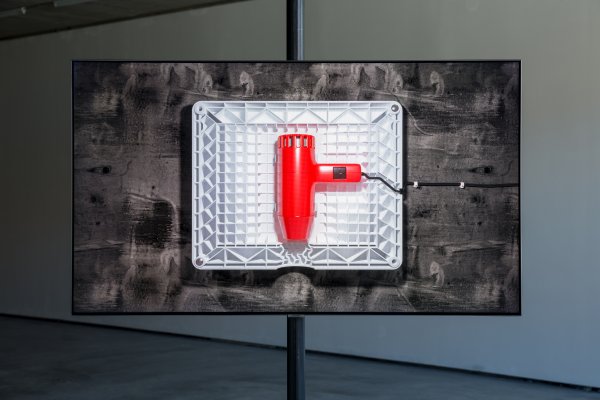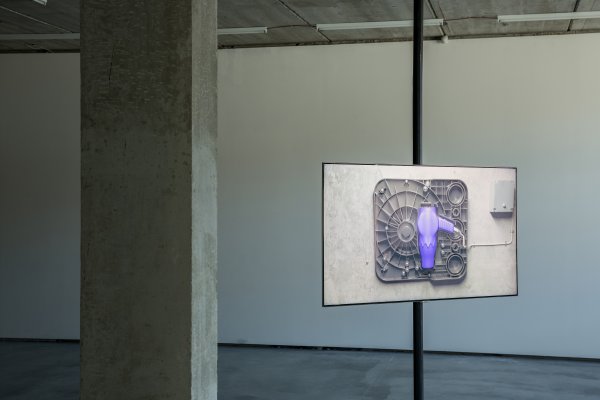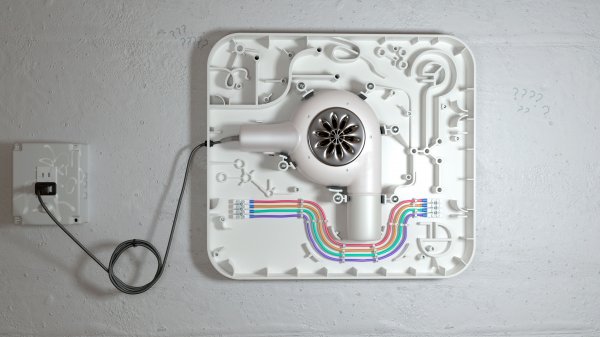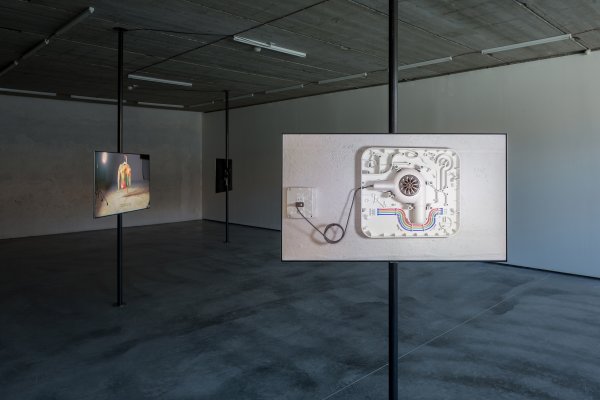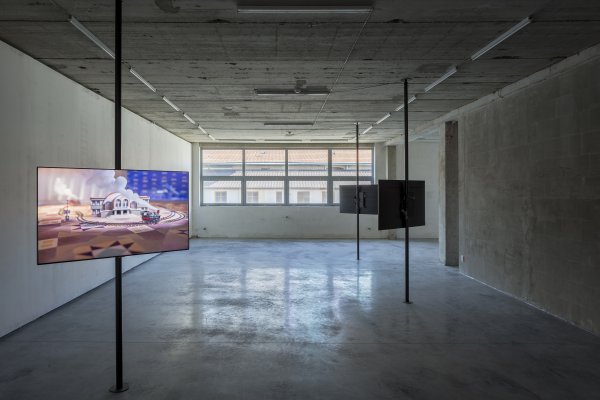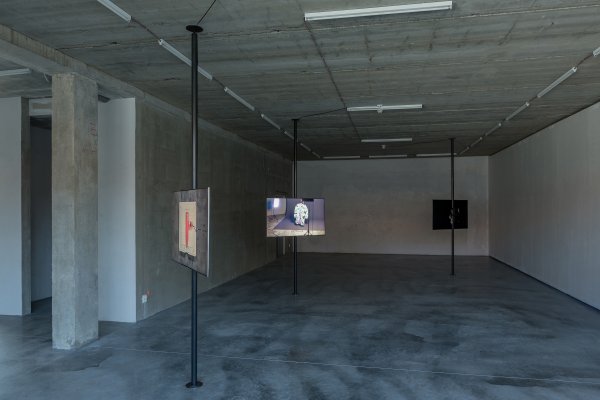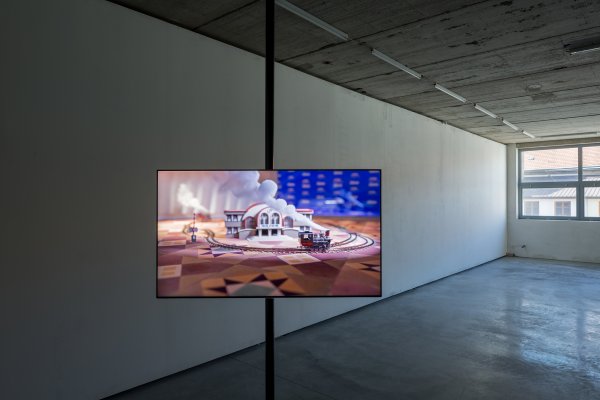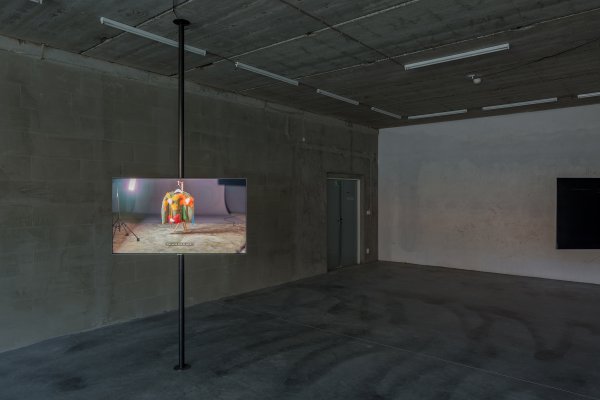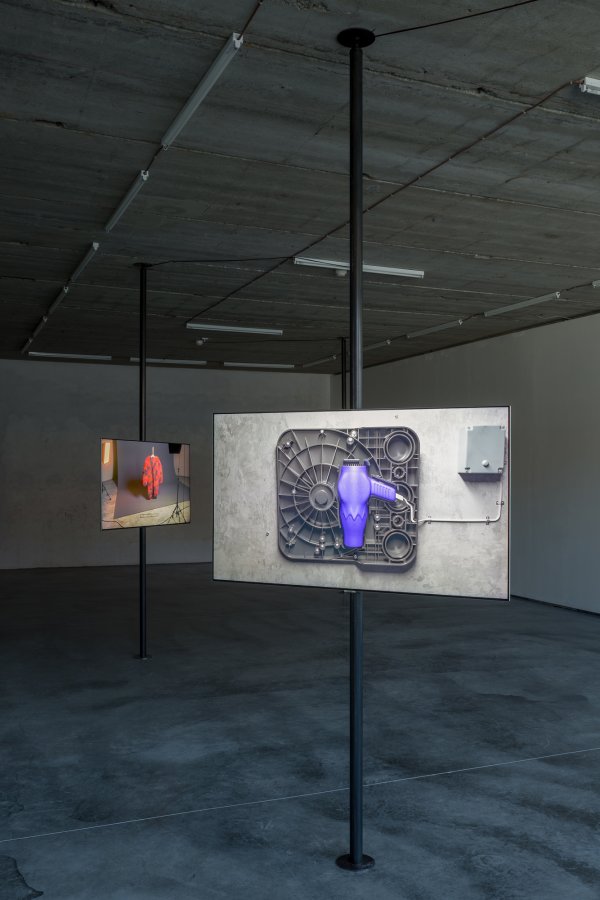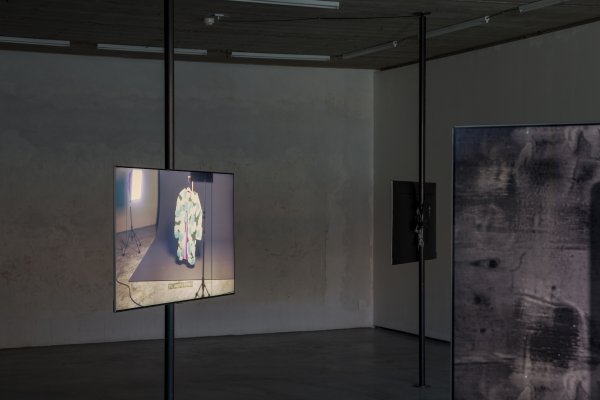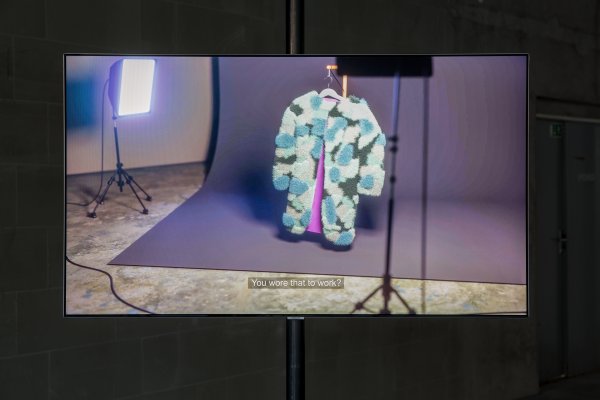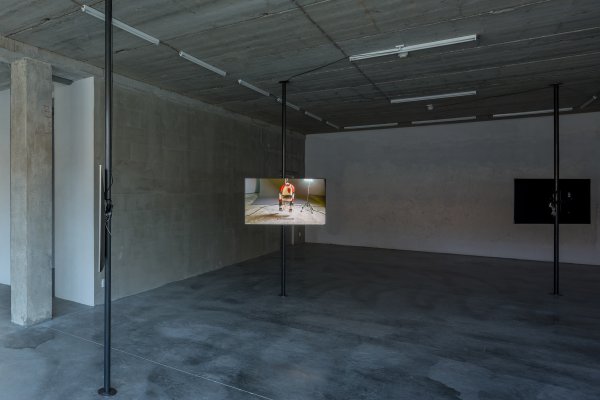Micah Hesse
- Text by Christina Gigliotti (EN)
- Text by Christina Gigliotti (CZ)
For the inaugural exhibition of Polansky Gallery’s newly opened space in Brno, Micah Hesse has prepared three new animated video works.
Each of the works poses a question originating in the curious musings of a wandering mind. The work Air Dryer imagines what might hide behind the unnecessarily large and ineffective hand dryers found in most public restrooms. Why are the cases for hand dryers so big, when hair dryers, on the other hand, perform the same function with a much more compact form?
In Hesse’s work, a potential cover-up is revealed: vintage hair dryers are fastened to the interior casings and operate as the functional element of the dryer. With the outer shell removed, the superfluous space is explored as a formal canvas of injection moulded plastic matrices, screws, and pseudo-functional wires.
In What You Wore to Work, scenes of fluffy, questionably fashionable sweaters dangle softly in a light breeze, while a simple, yet judgmental question lingers incessantly: “You wore that to work?”. The question, conveyed in the form of a single subtitle, is never spoken aloud, nor does its presence on screen ever cease. It drones on indefinitely like a persistently lurking thought.
Office culture demands conformity in behavior and uniform. Pushing the envelope is usually discouraged and met with stares of (real or perceived) disapproval from judgmental colleagues. Consciously, many of us will have been subject to anxious self-censorship when facing our wardrobe and deciding what to wear to work. Unconsciously, many of us have also fallen victim to the archetypal dream (or nightmare) of arriving at our workplace naked. In What You Wore to Work, the dream is not arriving naked, on the contrary, the dream conjures an arrival at work wearing one of the colorful sweaters that are on display in the video.
In the work Choo Choo, a model train set finds itself in the spotlight, surrounded by camera flashes and off-screen reporters. The interviewers place the the animated yet inanimate locomotives on the spot with questions that innocent steam engines can only respond to with blows of their steam whistles.
Trains and train stations are a ubiquitous motif in romantic narratives. This motif clashes with the innocent nature of the miniaturized train set that derives its pleasure from the dependable routine of a looping track, as well as the hobby-like joy of its construction.
The questions hint at vague romantic incidents. A brief encounter on a train? A missed connection? It becomes apparent that several connections are missed: from the two locomotives circling the station on a single track in opposite directions (yet narrowly avoiding crashes), to the ongoing interview with its severed bridge of understanding, and even the mismatch of the architectural style of the station itself.
Micah Hesse was born in 1991 in New Mexico and currently lives and works in New York City. Recent solo exhibitions include Shampaigne at Neu-Meister Bar Am in Berlin (2017). His work has been included in group exhibitions such as Mood Swings at Frei_Raum Q21 in Vienna (2017), Charrette at Kings Leap in New York City (2017), and The Kids Want Communism at Kunstraum Kreuzberg / Bethanien Berlin (2017).
Pro zahajovací výstavu v nově otevřeném brněnském prostoru Polansky Gallery připravil Micah Hesse tři nová animovaná videa.
Jednotlivá díla vyvolávají otázky, které se rodí v nepochopitelných zákrutách naší mysli. Práce s názvem Air Dryer (Vysoučeč) domýšlí, co by se mohlo skrývat za zbytečně velkými a neefektivními vysoučeči rukou, které najdeme na většině veřejných záchodků. Proč jsou krycí obaly na tyto vysoušeče tak veliké? Ruční fény přeci plní podobnou funkci v mnohem kompaktnějším provedení.
Hesse ve svých animacích odhalil potenciální kamufláž- staré fény na vlasy jsou připevněny k vnitřní konstrukci a fungují coby funkční element vysoušečů. Po odstranění vnějšího obalu se nadbytečný prostor ukáže být pouhou formální spletí umělohmotných matric, šroubů a pseudofunkčních drátů.
V práci What You Wore to Work (Co sis vzal na sebe do práce) se měkoučké, z módního hlediska poněkud extravagantní svetry pohupují v lehkém vánku za neustálé přítomnosti jednoduché, ale kritické otázky: “Tohle sis na sebe vzal do práce?”. Otázka ve formě jednoduchého titulku sice není vyřčena nahlas, zároveň ani z obrazovky nikdy nezmizí. Táhne se do nekonečna jako neodbytně vtíravá myšlenka.
Firemní kultura vyžaduje všeobecnou konformitu, v chování i oblečení. Jakákoli snaha o vybočení není žádoucí a setkává se s významně odmítavými nebo předstíraně chápavými pohledy kritických kolegů. Vědomě se před ranním odchodem do práce stáváme při výběru oblečení předmětem úzkostné autocenzury. Na nevědomé úrovni se zase stáváme oběťmi archetypálního snu (nebo noční můry), ve kterém do práce přicházíme nazí. V práci What You Wore to Work nevidíme sen o nahotě, ale naopak o příchodu do práce v některém z vystavených barevných svetrů.
V práci Choo Choo se do centra pozornosti dostává model vláčku obklopený blesky fotoaparátů a reportéry, kteří jsou mimo záběr. Rozpohybované, nicméně neživé lokomotivy se dostávají do úzkých. Nevinné parní stroje nedokáží na otázky odpovědět jinak, než pouhým houkáním a vypouštěním páry.
Vlaky a nádraží jsou častým námětem romantických vyprávění. Téma je v rozporu s nevinnou povahou miniaturizované vlakové sestavy, jejíž obliba se odvíjí od spolehlivé rutiny zacyklených kolejí a potěšení z kutilského provedení.
Otázky se točí okolo neurčitých romantických příhod. Náhodné setkání ve vlaku? Zmeškaný spoj? Je zřejmé, že tu nedošlo hned k několika spojením najednou: od dvou lokomotiv objíždějících stejnou zastávku na jednokolejce (a přesto se těsně vyhýbajících střetu), přes nekonečný rozhovor bez vzájemného porozumění, až po nesourodost architektonického stylu samotné vlakové stanice.
Micah Hesse se narodil v roce 1991 v Novém Mexiku. V současnosti žije a pracuje v New Yorku. Mezi nedávné sólové výstavy patří například Shampaigne v Neu-Meister Bar Am v Berlíně (2017). Jeho dílo bylo zařazeno do skupinových výstav jako Mood Swings na Frei_Raum Q21 ve Vídni (2017), Charrette v Kings Leap v New Yorku (2017) a Kids Want Communism na Kunstraum Kreuzberg / Bethanien Berlin (2017).
